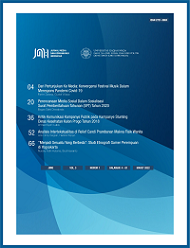Strengthening Data-Driven Policy Communication On Indonesia Economic Recovery Program Of Covid-19 In The Digital Landscape
Abdul Aziz(1*)
(1) Ministry of Finance, Indonesia, University of Southern California, USA
(*) Corresponding Author
Abstract
ABSTRACT
To recover from Covid-19 crisis, Indonesia needs to get the supports and confidence from the society, especially millennials as the backbone of the workfoces. The support can be done by implementing the effective communication strategies towards economic recovery programs. This policy research has intended to identify the available alternatives of policy communication strategies to fill the communication gap in disseminating economic recovery program to working millennials through big data analytic. Twitter has been chosen to illustrate the communication gap in terms of content messaging and communication actors between policy communicators and netizens, who represent millenials. Content/text analysis and social network analysis have been used to identify the problems and explore the options to solve the gap. The main findings showed that there was a gap between messages disseminated by policymakers and demanded information from netizens. Moreover, policy communication actors have been dominated by public institutions and ministries within a = 0.05, centering on Ministry of Finance, while the presences of other desired key players were still lower than expected.
Keywords: economic recovery program/policies, millennials, communication gap, social media analytics, Twitter, content/text analysis, social network analysis
ABSTRAK
Untuk dapat pulih dari krisis Covid-19, Indonesia perlu memperoleh dukungan dan kepercayaan dari masyarakat, khususnya generasi milenial sebagai tulang punggung tenaga kerja muda. Dukungan tersebut dapat dilakukan dengan menerapkan strategi komunikasi publik yang efektif terkait kebijakan pemulihan ekonomi nasional. Penelitian ini dimaksudkan untuk mengidentifikasi alternatif bauran strategi komunikasi kebijakan yang terbaik untuk mengisi gap komunikasi dalam mendiseminasikan program-program pemulihan ekonomi kepada generasi muda dengan menggunakan analisis big data. Twitter dipilih untuk menggambarkan gap komunikasi terkait pesan konten dan aktor komunikasi kunci dalam pola komunikasi publik antara komunikator kebijakan dan warganet (netizen) yang mewakili milenial. Analisis konten/teks dan analisis jaringan sosial (social network analysis) digunakan untuk mengidentifikasi masalah dan mengeksplorasi alternatif-alternatif strategi komunikasi kebijakan untuk menjembatani gap komunikasi yang ada. Hasil temuan utama menunjukkan bahwa terdapat gap antara pesan yang disebarluaskan oleh pembuat kebijakan dan warganet yang mencari informasi. Selain itu, dengan menggunakan a= 0,05 terindikasi bahwa para pelaku komunikasi kebijakan didominasi oleh lembaga publik dan kementerian, dengan pusat aktor komunikasi kunci pada Kementerian Keuangan. Sementara itu, kehadiran para aktor komunikasi kunci lain yang diharapkan juga turut berperan aktif masih lebih rendah dari yang diharapkan.
Katakunci: program/kebijakan pemulihan ekonomi, milenial, gap komunikasi, analisis media sosial, Twitter, analisis konten/teks, analisis jaringan sosial, social network analysis
Keywords
Full Text:
Abdul AzizReferences
Bardach, Eugene, and Patashnik, Eric M. (2016). A Practical Guide for Policy Analysis. The Eightfold Path to More Effective Problem Solving, fifth edition. Thousand Oaks, CA: Sage Publications.
BPS. (2021). Hasil Sensus Penduduk 2020 [2020 National Census Report]. Retrieved from https://www.bps.go.id/pressrelease/2021/01/21/1854/hasil-sensus-penduduk-2020.html
BPS. (2021). Februari 2021: Tingkat Pengangguran Terbuka [February 2021: Unemployment Rate]. Retrieved from https://www.bps.go.id/pressrelease/2021/05/05/1815/februari-2021--tingkat-pengangguran-terbuka--tpt--sebesar-6-26-persen.html.
Datareportal. (2021). Digital 2021: Indonesia. Hootsuite and WeAreSocial collaborative report. Retrieved from https://datareportal.com/reports/digital-2021-indonesia#:~:text=There%20were%20202.6%20million%20internet,at%2073.7%25%20in%20January%202021.
Deloitte. (2019, September). Millennials in Industry 4.0: A Gift or a Threat to Indonesian Human Resources?. Deloitte Indonesia Perspective, First Edition. Retrieved from https://www2.deloitte.com/content/dam/Deloitte/id/Documents/about-deloitte/id-about-dip-edition-1-chapter-2-en-sep2019.pdf.
Dunn, William N. (2018). Public Policy Analysis: An Integrated Approach (pp. 404, Sixth Edition). New York: Routledge.
Edelman. (2021). Edelman Trust Barometer 2021: Country Report – Trust in Indonesia. Retrieved from https://www.edelman.com/sites/g/files/aatuss191/files/2021-04/2021%20Edelman%20Trust%20Barometer_Indonesia%20Country%20Report.pdf.
Ferrara, E. and Yang, Z. (2015). Quantifying the effect of sentiment on information diffusion in social media. PeerJ Computer Science 1:e26 https://doi.org/10.7717/peerj-cs.26.
Badan Kebijakan Fiskal. (2020). Media Briefing: Program Pemulihan Ekonomi Nasional [Media Briefing: National Economic Recovery Program]. Retrieved from https://www.kemenkeu.go.id/media/15116/media-briefing-kabkf.pdf.
Francis, T. and Hoefel, F. (2018, November 12). ‘True Gen’: Generation Z and its implications for companies. Published by McKinsey Company. Retrieved from https://www.mckinsey.com/industries/consumer-packaged-goods/our-insights/true-gen-generation-z-and-its-implications-for-companies#.
Gandomi, Amir, and Haider, Murtaza. (2015). Beyond the hype: Big data concepts, methods, and analytics. International Journal of Information Management, Volume 35, Issue 2, April 2015, Pages 137-144. Retrieved from https://doi.org/10.1016/j.ijinfomgt.2014.10.007.
IMF. (March 2, 2021). Indonesia: 2020 Article IV Consultation-Press Release; Staff Report; and Statement by the Executive Director for Indonesia. Retrieved from https://www.imf.org/en/Publications/CR/Issues/2021/03/01/Indonesia-2020-Article-IV-Consultation-Press-Release-Staff-Report-and-Statement-by-the-50131.
Karimi, Shayan & Futuhi, Ehsan. (2020). Analyzing Twitter text messages related to Covid-19. 10.13140/RG.2.2.31873.89449/1.
Lewis, Seth C., Zamith, R., Hermida, A. (2013). Content Analysis in an Era of Big Data: A Hybrid Approach to Computational and Manual Methods. Journal of Broadcasting and Electronic Media, 57:1, 34-52. Retrieved from https://doi.org/10.1080/08838151.2012. 761702.
OECD (2020). OECD Economic Outlook, Volume 2020 Issue 2, Chapter Indonesia. Retrieved from https://read.oecd-ilibrary.org/economics/oecd-economic-outlook/volume-2020/issue-2_39a88ab1-en#page187.
______ (2020). The OECD Digital Government Policy Framework: Six Dimensions of A Digital Government. Retrieved from https://www.oecd.org/governance/the-oecd-digital-government-policy-framework-f64fed2a-en.htm
Stokman, F.N. (2001). Network: Social. International Encyclopedia of the Social and Behavioral Sciences, 2001, pages 10509-10514. Retrieved from https://doi.org/10.1016/B0-08-043076-7/01934-3.
UNDR. (2021). Human Development Reports. Indonesia. Retrieved from http://hdr.undp.org/en/countries/profiles/IDN.
World Bank. (2020). Retrieved from https://data.worldbank.org/indicator/SP.POP.TOTL?end=2014&most_recent_value_desc=true&start=1960
Article Metrics
Refbacks
- There are currently no refbacks.
Copyright (c) 2022 Jurnal Media dan Komunikasi Indonesia
| Jurnal Media dan Komunikasi Indonesia (Online ISSN 2721-396X) is published by the Department of Communication Science (DIKOM), Faculty of Social Science and Political Science (FISIPOL), Gadjah Mada University |












